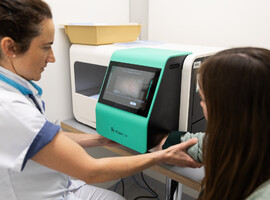De elektronische neus is een techniek in opkomst bij de diagnostiek en behandeling van longkanker. E-nose-technieken die metingen van de uitgeademde luchtcomponent gebruiken, kunnen longkanker detecteren met een gevoeligheid van 71% tot 96% en een specificiteit van 33% tot 100%. Momenteel ontbreken echter gestandaardiseerde bemonsterings- en analysemethoden en validatietechnieken, wat vergelijking tussen studies en klinische implementatie nog belemmert. Wanneer deze succesvol worden weggenomen kan de e-nose bij longkanker een hoge vlucht nemen.
Longkanker is wereldwijd verantwoordelijk voor de meeste kankergerelateerde sterfte. Bij het merendeel van longkankerpatiënten wordt de ziekte pas in een gevorderd stadium vastgesteld. Om de aan longkanker gerelateerde sterfte te verkleinen is het essentieel om de ziekte in een vroeg stadium vast te stellen, bij voorkeur in asymptomatische patiënten (1).
Hiervoor zijn diverse screeningsprogramma’s ontwikkeld, de meeste met CT-scans. Deze hebben echter diverse nadelen waaronder een groot aantal valspositieve bevindingen en beperkingen t.a.v. kosten en de selectie van de juiste doelgroep. Het toevoegen van een niet-invasieve biomarker zou de effectiviteit van zulke programma’s kunnen verhogen (2). Verder zou de behandeling effectiever kunnen worden wanneer artsen tijdens de behandeling en bij follow-up de beschikking zouden hebben over een niet-invasieve biomarker (3, 4).
Wenst u hierover meer te lezen, dan verwijzen wij u graag naar de integrale tekst.



















